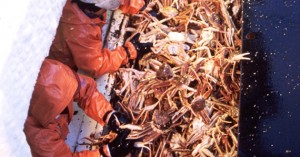Alaska’s seafood industry is global in stature and has a $5.8-billion economic impact on the state and local economies. That’s the conclusion of the report The Seafood Industry in Alaska’s Economy, prepared by Northern Economics of Anchorage and commissioned by the Marine Conservation Alliance, At-sea Processors Association and the Pacific Seafood Processors Association.
“Alaska’s seafood industry has played a major role in the state’s history and
remains a major part of Alaska’s economy today, with more jobs than any other private sector spread from the biggest cities to the smallest villages,” said David Benton, executive director of MCA. “With key issues affecting fisheries and fishing communities facing the Legislature and Congress, this report is a vivid reminder of the importance of fisheries throughout the entire Alaska economy.”

Among the findings of the report:
GLOBAL STATURE
- If Alaska were a nation, it would place 9th among seafood producing countries.
- The harvest of Bering Sea pollock, cod and other groundfish (2 million metric tons annually) ranks among the largest fisheries in the world.
- Alaska produces 42 percent of the world’s harvest of wild salmon and 80 percent of the production of high value species such as sockeye, king and coho salmon.
NATIONAL LEADER
- Alaska accounted for 62 percent of all seafood landings in the United States in 2007.
- Unalaska/Dutch Harbor has reigned as the national top fishing port in terms of volume for decades and is the nation’s number 2 port in terms of ex vessel value.
- Kodiak is number 3 on the top 20 port list in terms of value of fish caught, along with Naknek King Salmon (7), Seward (9), Sitka (10), Cordova (11), Homer (13) and Petersburg (16).
- Akutan, King Cove and Sand Point would also make the top‐20 were it not for confidentiality requirements.
STATEWIDE SIGNIFICANCE
- The overall value of the Alaska seafood industry is over $1.5 billion paid to fishermen in 2007 and $3.6 billion at the wholesale level.
- Direct and induced economic output boosts the total to $5.8 billion, more than that of mining or tourism sectors and second only to oil and gas
- Alaska’s seafood industry generates $71 million in state taxes and fees annually in addition to local fish taxes.
LOCAL IMPACT
- The seafood industry is the largest private sector employer creating 56,600 direct and 22,000 indirect jobs annually, more jobs than oil and gas and mining combined.
- Jobs are spread widely across the state, with more than 10,000 jobs each in Southeast, South Central, the Aleutian Islands and Bristol Bay; 5,000 jobs in Kodiak and 2,500 jobs in the Northwest, Arctic, Yukon, and Kuskokwim region.
- The Community Development Quota program, an allocation of the Bering Sea catch given to coastal communities generates more than $100 million in revenue annually, employs 2,000 workers, pays $15 million in wages and invests millions more in training.
Positive trend
- The inflation adjusted wholesale value of Alaska seafood has steadily increased over the past five years from $2.88 billion in 2003 to $3.63 billion in 2007, an increase of 26 percent and led by a 62 percent increase in the wholesale value of salmon.
- State and federal fishery managers set catch allocations at scientifically set levels to protect the resource. As a result, no stocks of groundfish are considered overfished.
- Key habitat areas are closed to protect the broader ocean ecosystem totaling more than five times the entire US National Park System.
- Alaska fisheries operated under limited access or catch share quota systems now recognized as a key strategy to prevent overfishing.
- National Geographic listed Alaska as one of only three well‐managed fisheries in the world, the others being Iceland and New Zealand.
“Wild fish stocks are a dynamic resource, subject to swings in abundance, Alaska’s Seafood Industry continues to earn superlatives thanks to a commitment to stewardship and sustainability,” Benton said. “With continued science-based management, Alaska’s seafood industry is a growing, sustainable and vital part of the Alaska economy.”
Based in Juneau, the Marine Conservation Alliance is a seafood industry trade association that represents most of the fishermen, vessel owners, processors and many communities involved in the Bering Sea and Gulf of Alaska Groundfish and crab fisheries. Among its members are the At-sea Processors Association and the Pacific Seafood Processors Association.
